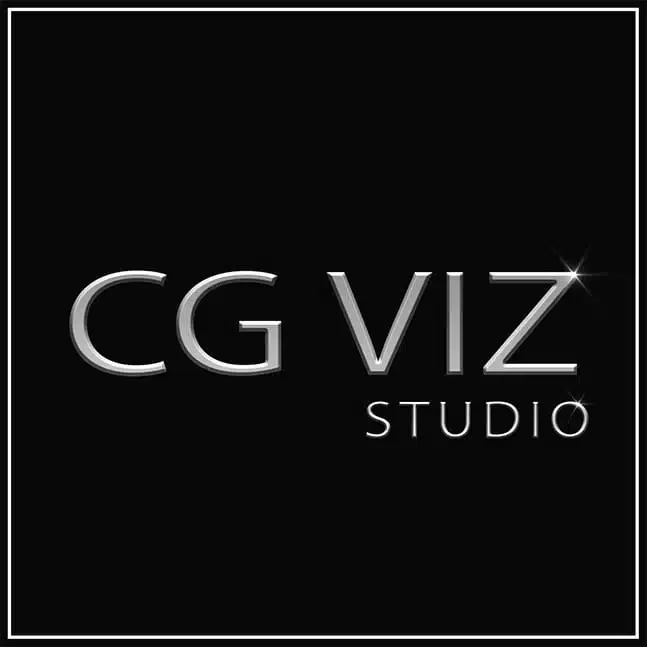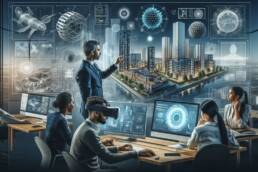The advent of 3D visualization has brought a transformative change to architectural design, offering a new dimension of creativity, precision, and interactivity. CG Viz Studio, with its expertise in creating detailed 3D images, renderings, and animations, is at the forefront of this revolution, providing architects, real estate developers, and marketers with powerful tools to visualize and communicate their projects before they materialize. This article explores the various facets of how 3D visualization is reshaping the future of architectural design, highlighting the benefits, emerging technologies, and real-world applications that are changing the game.
Key Takeaways
- 3D visualization by companies like CG Viz Studio is enhancing client engagement and communication, allowing for clearer understanding and approval of architectural designs.
- The integration of emerging technologies such as VR and AI into 3D visualization is creating more immersive and interactive experiences for clients and designers alike.
- With the ability to pre-visualize projects, 3D visualization is reducing costs, saving time, and mitigating risks during the design and construction phases.
- The use of 3D visualization tools is democratizing design processes, enabling smaller architecture firms to compete with larger entities by showcasing high-quality visuals.
- Real-world case studies and testimonials from CG Viz Studio clients underscore the tangible benefits of 3D visualization in architectural projects.
Revolutionizing Architectural Presentations with 3D Visualization
The Role of 3D Visualization in Client Communications
In our pursuit to deliver unparalleled architectural experiences, we’ve embraced 3D visualization as a cornerstone of client communication. This transformative approach allows us to present complex architectural concepts with clarity and precision. By crafting detailed and photorealistic renders, we bridge the gap between technical jargon and the client’s vision, ensuring that every nuance of the proposed design is understood and appreciated.
Our high-end 3D visualization services for architectural projects revolutionize design communication and decision-making. Enhances collaboration, client engagement, and marketing through immersive experiences and high-quality visuals.
The process of 3D visualization involves creating graphical content using specialized software, which enables us to simulate structures and behaviors in a virtual environment. This not only aids in visual storytelling but also serves as a powerful tool for project planning, allowing for a detailed preview that can preemptively address potential issues. Here’s how we streamline our client communications with 3D visualization:
- We provide stunning visualizations that facilitate clear understanding among stakeholders.
- Our photorealistic images offer full control over every aspect of the project’s presentation.
- Lifelike models produced using advanced software grant clients immersive experiences beyond conventional 2D drawings.
- Clear visuals are essential in online meetings, making discussions more engaging and productive.
Ultimately, 3D renders simplify processes, expand our client base, and showcase our architectural prowess on a global stage. Staying current with this technology is not just an advantage—it’s imperative for staying competitive in today’s architecture world.
Enhancing Real Estate Marketing with Immersive Visuals
In our pursuit to revolutionize real estate marketing, we’ve embraced the power of architectural visualization, or arch viz, to create more engaging and realistic property presentations. 3D visualization acts as a bridge, connecting potential buyers to properties before they even step foot inside. This immersive experience is not just about fancy 3D pictures; it’s about crafting a narrative that resonates with clients, making them feel an emotional attachment to the space.
By leveraging advancements in rendering technologies, we can quickly generate photorealistic images that captivate and communicate the true essence of a property.
Our approach has proven effective, as evidenced by the positive feedback from realtors who have seen an increase in sales and exposure. Here’s a snapshot of the benefits we’ve observed:
- Enhanced buyer engagement through virtual tours
- Elevated marketing materials with high-quality renders
- Streamlined client decision-making processes
We’re committed to pushing the boundaries of real estate marketing, ensuring that every visual we create not only showcases a property but also tells its unique story.
Streamlining Design Approval Processes
We’ve witnessed firsthand how 3D visualization streamlines the design approval process, enhancing communication and reducing the time from concept to approval. By presenting lifelike models and immersive experiences, clients can quickly grasp complex architectural concepts and provide immediate feedback.
Iterative design is key in this process. With 3D visualization tools, we can rapidly incorporate client feedback, making real-time adjustments to the design. This iterative loop is succinctly captured in the following steps:
- Present the initial 3D visualization to the client.
- Gather client feedback and specific requests.
- Adjust the design accordingly and present the updated version.
- Repeat the cycle until full approval is achieved.
The ability to pre-visualize projects in three dimensions not only excites clients but also significantly mitigates risks associated with design misunderstandings. It’s a transformative approach that ensures all stakeholders are aligned before construction begins, saving both time and resources.
Moreover, the integration of 3D visualization into the approval process fosters a collaborative environment. Team members from various disciplines can converge on a unified vision, ensuring that the final design is both functional and aesthetically pleasing. This collaborative spirit is reflected in the positive outcomes and client satisfaction we’ve consistently achieved.
The Impact of 3D Visualization on Design and Construction
Improving Accuracy and Efficiency in Construction Planning
We’ve seen firsthand how 3D visualization tools are transforming the construction planning phase. By providing a detailed view of architectural projects, 3D visualization enhances precision and allows for design adjustments before construction begins. This preemptive approach is crucial for avoiding costly errors and delays.
italics Virtual Reality (VR) technology, in particular, has become a game-changer. It offers a level of detail that ensures all stakeholders can visualize and understand the project in full before a single brick is laid. Here’s how VR contributes to construction planning:
- Precision and Clarity: Detailed views for precise planning.
- Cost Efficiency: Early identification of design flaws to save money.
- Enhanced Collaboration: Real-time feedback and adjustments among teams.
By integrating VR into our workflow, we not only improve the accuracy of our construction plans but also significantly boost overall efficiency. This leads to a smoother building process with fewer surprises.
Moreover, the ability to spot design issues early on minimizes risks and facilitates better material choices, ultimately saving time and money. It’s a win-win for architects, builders, clients, and investors alike. As we continue to improve construction efficiency, we’re committed to leveraging these technologies to deliver the best possible outcomes for our projects.
Facilitating Collaboration Amongst Design Teams
In our journey to enhance architectural design, we’ve embraced 3D visualization as a pivotal tool for collaboration. It allows project team members to work in unison, ensuring seamless coordination throughout the design and construction phases.
With collaborative rendering technologies on the rise, multiple designers can now work on similar designs using multiple screens. This not only fosters teamwork but also significantly reduces delays in the design process.
Here’s how 3D visualization is revolutionizing collaboration:
- Virtual client meetings enable detailed project reviews with global clients.
- Cross-disciplinary workshops enrich the design process through diverse expertise.
- Real-time feedback and unified understanding minimize miscommunication and errors.
By integrating these practices, we’ve seen a marked improvement in communication, client satisfaction, and the integration of emerging technologies. It streamlines design processes, saves time, and ultimately, cuts costs.
Reducing Costs and Mitigating Risks with Pre-Visualization
We understand the importance of pre-visualization in the architectural design process. By integrating advanced 3D visualization techniques, we can detect potential issues before construction begins, saving both time and money. Early identification of design flaws is crucial in preventing costly mistakes during the actual building phase.
For instance, consider the benefits of Building Information Modeling (BIM) for contractors during the pre-construction stage:
- Early flaw identification
- Precise scheduling
- Effective risk management
- Clear communication of client expectations
- Cost savings through accurate material estimation
By adopting 3D visualization tools, we enable a more collaborative and flexible approach to design, allowing for quick adjustments that minimize resource waste.
Our commitment to innovation in pre-visualization not only enhances the efficiency of the design process but also significantly reduces the risks associated with construction. This proactive approach ensures that our projects are not only aesthetically pleasing but also economically viable and structurally sound.
Emerging Technologies in 3D Architectural Visualization
Integrating Virtual Reality for Enhanced Client Experiences
We’ve embraced the transformative power of Virtual Reality (VR) to elevate the client experience in architectural design. With VR technology, clients can navigate the virtual model by clicking on needed locations, giving them the freedom to explore every corner of the design. This level of interactivity is unprecedented, allowing clients to truly immerse themselves in the space before it’s built.
Virtual Reality helps us create three-dimensional interiors that seem realistic and immersive. Clients can view and interact with their interior concept before practical implementation, ensuring their vision is fully realized.
Our commitment to integrating VR into our workflow is not just about staying ahead of the curve; it’s about providing an unparalleled service that brings client satisfaction to new heights.
The benefits of VR in architecture are numerous, and we’re just scratching the surface. Here’s a glimpse of what’s possible:
- Integration with AI for optimized design processes
- Increased accessibility as VR technology becomes more affordable
- Enhanced realism with future VR advancements
We’re excited to see where this journey takes us and our clients, as we continue to push the boundaries of what’s possible in architectural visualization.
The Advancements in Real-Time Rendering
We’ve witnessed a transformative shift in architectural visualization with the advent of real-time rendering. This technology allows us to present and manipulate 3D graphics instantaneously, a leap forward from the traditional, time-consuming rendering processes. The impact on client engagement and project efficiency is profound.
Real-time rendering not only captivates clients with interactive experiences but also streamlines the design workflow. Changes can be made on the fly, providing immediate visual feedback. This agility is crucial in today’s fast-paced design environment, where time is often of the essence.
The integration of advanced GPUs and sophisticated algorithms has propelled real-time rendering to the forefront of 3D visualization, setting the stage for an exciting future in architectural design.
Here’s a glimpse into the benefits of real-time rendering:
- Enhanced client presentations with interactive elements
- Rapid iteration and decision-making during the design phase
- Improved collaboration between architects, designers, and stakeholders
As we look ahead, the trajectory for real-time rendering is steeply upward, promising even more immersive and efficient design processes.
Leveraging AI for Smarter Design Iterations
We’ve embraced the power of artificial intelligence to transform the way we approach architectural design. AI-assisted generative designs allow us to explore a multitude of options, tailoring each iteration to the unique requirements of a project. By harnessing AI, we can rapidly produce multiple design concepts, ensuring energy efficiency and aesthetic appeal are at the forefront of our creations.
AI technologies are pivotal in enhancing decision-making and project collaboration, offering realistic visualizations that push the boundaries of traditional design methods. Our iterative design process has become more dynamic, with AI enabling us to incorporate feedback and refine concepts in real-time. This not only improves the quality of the final product but also streamlines communication with our clients.
We foresee a future where AI’s role in 3D rendering will be indispensable, creating visuals that are not only stunning but also rich with data-driven insights.
Here’s how we leverage AI in our design iterations:
- Monitoring customer preferences to predict architectural trends
- Generating renderings that communicate effectively with clients
- Managing projects with enhanced precision
By integrating AI into our workflow, we’re not just designing buildings; we’re crafting smarter, more responsive environments that resonate with the needs of those who inhabit them.
The Future of 3D Modeling and Animation in Architecture
Predicting Trends with Data-Driven Design
As we embrace the transformative power of 3D visualization, we find ourselves at the forefront of architectural innovation. Data-driven design is not just a buzzword; it’s a strategic approach that leverages historical data, current market trends, and advanced analytics to predict and shape the future of architectural design. By analyzing patterns and preferences, we can anticipate client needs and create designs that are both aesthetically pleasing and functionally relevant.
With the integration of real-time rendering and AI, the potential for data-driven design is expanding. We can now simulate countless design iterations with speed and precision, ensuring that every decision is informed by data.
The following list highlights the key benefits of data-driven design in 3D visualization:
- Enhanced decision-making through predictive analytics
- Streamlined workflows with automated design adjustments
- Increased client satisfaction by aligning designs with expectations
As we continue to explore the capabilities of data-driven design, we remain committed to delivering innovative solutions that resonate with our clients and lead the industry.
The Evolution of 3D Animation in Architectural Storytelling
We’ve witnessed a remarkable transformation in architectural storytelling, from static hand-drawn sketches to dynamic and immersive 3D animations. The evolution of 3D visualization technologies has not only enhanced the way we present designs but also how we engage with clients and stakeholders. The future trends in this field are pointing towards a deeper integration of artificial intelligence and the Internet of Things (IoT), further shaping our design processes and communication methods.
- Engaging storytelling through 3D animation captivates interest and conveys the design concept effectively.
- Advanced CGI tools accelerate project stages, from initial design to final construction.
- Real-time rendering and VR are revolutionizing client presentations, offering immersive experiences.
We are at the cusp of a new era where 3D animation is not just a tool for visualization but a medium for conveying complex architectural narratives. This shift is empowering architects to create more compelling and interactive stories that resonate with audiences.
The integration of these technologies is not only about aesthetics; it’s about delivering a clearer understanding of the proposed spaces. As we continue to innovate, we remain committed to providing our clients with the most advanced and effective visualization services available.
Sustainable Design through Advanced 3D Modeling
We are at the forefront of sustainable design, leveraging advanced 3D modeling to pioneer a future where architecture is in harmony with the environment. Through simulations and modeling, we can analyze the environmental performance of buildings, predict energy consumption, and refine designs to optimize their sustainability.
Our commitment to sustainable futures is unwavering. We integrate eco-friendly visualization techniques to ensure that our projects not only meet but exceed the highest standards of environmental responsibility.
By employing 3D visualization, we can detect project errors early, avoiding costly and resource-intensive corrections later in the construction process. This proactive approach is not just about cost savings—it’s about reducing our ecological footprint and promoting a greener construction industry.
Here’s how 3D modeling contributes to sustainable design:
- Enables detailed analysis of materials and their impact
- Facilitates the creation of energy-efficient structures
- Allows for the testing of various environmental scenarios
- Supports the design of buildings that blend with their natural surroundings
Client Perspectives and Case Studies on 3D Visualization
Success Stories from CG Viz Studio Collaborations
At CG Viz Studio, we’ve had the privilege of collaborating with a diverse array of clients, each with their unique vision and challenges. Our commitment to transforming ideas into compelling visuals has led to numerous success stories that we’re proud to share. Overcoming challenges, we’ve made 3D visualization not only accessible but highly effective for all our partners.
- Peter Chung praised our organized workflow and rendering quality, emphasizing our responsiveness to client needs.
- Tom Ingleton highlighted our ability to deliver under tight deadlines, creating an explainer video that resonated with his audience.
- Anderson Creed and many others have commended our skilled team for meeting project deadlines with exceptional 3D renderings.
Our success is measured by the satisfaction of our clients and the tangible impact our visualizations have on their projects.
We’ve seen firsthand how our visualizations can excite clients and stakeholders, bringing clarity and enthusiasm to the design and approval process. The testimonials from our clients serve as a testament to the value we add through our expertise in 3D visualization.
Client Testimonials: The Tangible Benefits of 3D Visualization
We’ve seen firsthand the transformative power of 3D visualization in our clients’ experiences. Clients can better assess how well the design fits their needs with detailed 3D renderings, providing reassurance and reducing risk. Our commitment to delivering photorealistic visuals has maximized the return on investment for our clients, impressing stakeholders and enhancing marketing efforts.
Here’s a snapshot of the feedback we’ve received:
- "Awesome visualization experts to work with. Excellent rendering quality." – Peter Chung
- "Outstanding…fantastic animation…great response on social media." – Tom Ingleton
- "Best 3D Archviz rendering studio…very skilled and completed my project under my deadline." – Anderson Creed
Our clients’ testimonials reflect the significant impact that 3D visualization has on project approval rates and marketability. The ability to pre-visualize designs has not only streamlined the approval process but also sparked excitement and confidence among stakeholders.
By integrating cutting-edge technology and artistic expertise, we ensure that every project tells a compelling story, resonating with the audience and leaving a lasting impression.
Case Study Analysis: Before and After 3D Visualization Implementation
We’ve seen firsthand the transformative power of 3D visualization in our projects. One such example is a unique interior project where the home owners were significantly influenced by the immersive visuals we provided. Before the implementation of 3D visualization, the clients struggled to grasp the essence of the design through traditional 2D drawings. However, after we introduced detailed 3D renderings, the clients could instantly connect with the design, leading to a swift approval process.
The clarity and precision that 3D visualization brings to the table are unparalleled. It not only enhances the client’s understanding but also empowers architects and designers to convey their concepts more effectively.
Here’s a quick comparison of the project’s timeline and client satisfaction levels before and after the adoption of 3D visualization:
| Project Phase | Timeline Before 3D | Timeline After 3D | Client Satisfaction Before | Client Satisfaction After |
|---|---|---|---|---|
| Conceptual Design | 4 weeks | 2 weeks | Moderate | High |
| Design Development | 6 weeks | 3 weeks | Moderate | Very High |
| Final Approval | 8 weeks | 4 weeks | Low | Exceptional |
The table clearly shows a reduction in the timeline for each phase and a significant improvement in client satisfaction. This case study is a testament to the fact that 3D visualization is not just a tool for presentation but a catalyst for better communication and faster project delivery.
Discover how our clients have transformed their businesses with our high-end 3D visualization services. From architectural firms to product designers, our case studies showcase the impact of our work. Ready to see what we can do for you? Visit our [Portfolio] to explore our gallery of success stories and learn how we can bring your visions to life. Don’t just take our word for it; let our clients’ experiences guide your decision to partner with us for your 3D visualization needs.
Conclusion
In the realm of architectural design, 3D visualization has emerged as a transformative force, reshaping the way architects, designers, and clients collaborate and realize their visions. Companies like CG Viz Studio are at the forefront of this revolution, offering advanced rendering services that bring projects to life before construction even begins. The glowing testimonials from satisfied clients across the globe underscore the value and impact of these services. As we look to the future, it’s clear that 3D visualization will continue to be an indispensable tool, driving innovation, enhancing communication, and ultimately leading to more informed decision-making in the architectural process. The potential for growth in this field is boundless, promising a new era of design where the only limit is the imagination.
Frequently Asked Questions
What is CG Viz Studio and what services do they offer?
CG Viz Studio is a professional 3D visualization company that specializes in creating 3D images, renderings, and animations for architectural projects. They offer a range of services including 3D architectural visualization, 3D design and animation, scale models, interior and exterior visualization, industrial modeling, CAD services, and product rendering.
How does 3D visualization benefit architects and real estate developers?
3D visualization provides architects and real estate developers with highly realistic images or animations of their projects before construction begins. This helps in decision-making regarding design, materials, and allows for effective promotion of the projects to potential buyers or investors.
Can CG Viz Studio’s 3D models be used for commercial projects?
Yes, CG Viz Studio offers a selection of high-quality 3D models through their shop, suitable for various design projects, including commercial use. These assets include textures, architectural elements, and models in both low and high-poly styles.
What do clients say about their experience with CG Viz Studio?
Clients have praised CG Viz Studio for their high-quality renderings, efficient workflow, and excellent communication. Testimonials reflect satisfaction with the studio’s ability to meet tight deadlines, provide marketing-ready imagery, and offer creative input that enhances the final visuals.
How does CG Viz Studio integrate emerging technologies into their services?
CG Viz Studio stays at the forefront of technological advancements by integrating virtual reality, real-time rendering, and AI to provide enhanced client experiences and smarter design iterations. These technologies allow for more immersive visuals and efficient design processes.
What is the future of 3D visualization in architectural design?
The future of 3D visualization in architectural design is bright, with advancing technology enhancing communication, collaboration, and innovation in construction and design. It is expected to play a vital role in making processes faster, more effective, and adaptable to future needs.



